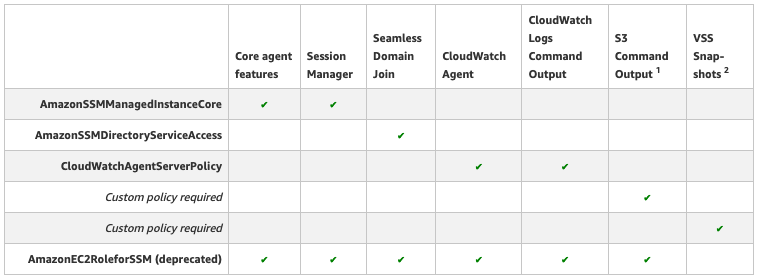AWS Cloud Operations & Migrations Blog
Tag: AWS Systems Manager
Applying managed instance policy best practices
Since AWS Systems Manager was launched, the service has continued to add new features for customers to use. Many features are enabled by granting your Amazon EC2 instances and on-premises servers access to Systems Manager using an AWS Identity and Access Management (IAM) role with the necessary permissions. To provide customers more flexible, fine-grained permission […]
Automate RDS Aurora Snapshots for disaster recovery
It is important to have a well-defined proactive disaster recovery strategy for efficient and uninterrupted flow of data across an organization. This applies to all components of your application architecture, including the database layer. While Amazon Aurora database clusters are fault-tolerant and highly available by design, for disaster recovery use cases, customers prefer to keep […]
Improve governance and business agility using AWS Management and Governance videos
Curious to find solutions for managing your business on AWS? We always look at different ways to better serve our customers. One of the ways is to offer you video-based hands-on solutions addressing the common challenges faced by enterprises in managing and governing their AWS environments. Here’s a summary of videos published in AWS Management […]
Deploy Conformance Packs across an Organization with Automatic Remediation
AWS Config conformance packs help you manage configuration compliance of your AWS resources at scale – from policy definition to auditing and aggregated reporting using a common framework and packaging model. Many enterprises have multiple AWS accounts to manage their AWS infrastructure and demand an easy way to manage compliance policy definitions across their organization. […]
Providing temporary instance permissions with AWS Systems Manager Automations
Instances might have to call certain API actions or access certain resources during an AWS Systems Manager Automation execution. What if you don’t want to apply the additional permissions to the instance’s existing instance profile? In this post, I show you how to provide temporary permissions to instances when executing an Automation within the document […]
Using AWS Systems Manager Run Command to submit Spark/Hadoop jobs on Amazon EMR
Many customers use Amazon EMR with Apache Spark to build scalable big data pipelines. For large-scale production pipelines, a common use case is to read complex data from a variety of sources. This data must be transformed to make it useful to downstream applications, such as machine learning pipelines, analytics dashboards, and business reports. Such […]
Using AWS Systems Manager Change Calendar to prevent changes during critical events
When applications and their development teams grow or evolve around service-specific independent teams, coordination and visibility among projects, deployments and operational events become a critical issue. AWS customers use multiple AWS accounts for many different reasons, adding guardrails around resources and increasing the need for collaboration between different AWS account owners and teams. Previously, these […]
Controlling your AWS costs by deleting unused Amazon EBS volumes
Customers across industries and verticals consider cost management as one of their top priorities. Limited visibility into a volume’s lifecycle can result in costs for unutilized resources. AWS builds cost-management products to access, organize, understand, control, and optimize costs on AWS. Unused and overlooked Amazon EBS volumes contribute to AWS costs. The lifecycle of EBS […]
Amazon S3 bucket compliance using AWS Config Auto Remediation feature
AWS Config keeps track of the configuration of your AWS resources and their relationships to your other resources. It can also evaluate those AWS resources for compliance. This service uses rules that can be configured to evaluate AWS resources against desired configurations. For example, there are AWS Config rules that check whether or not your […]
How to self-service manage AWS Auto Scaling groups and Amazon Redshift with AWS Service Catalog Service Actions
Some of the customers I work with provide AWS Service Catalog products to their end-users to enable self-service for launching and managing Amazon Redshift, EMR clusters or web applications at scale using AWS Auto Scaling groups. These end-users would like the ability to self-manage these resources, for example, be able to take a snapshot of […]







